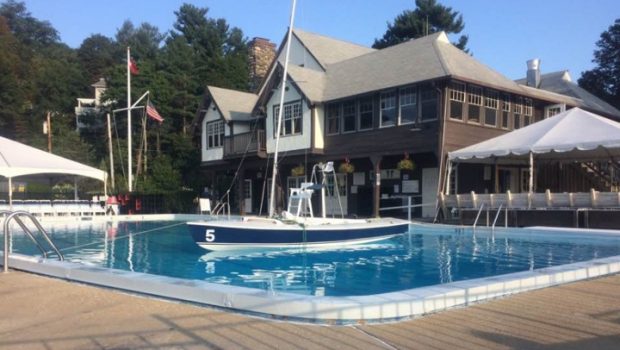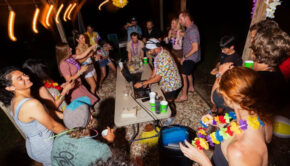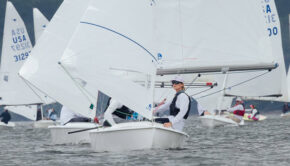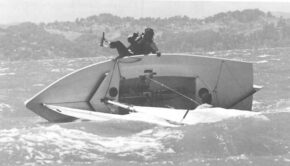Bowers and Rabin Win Snipe Nationals
Published on August 25th, 2017
Winchester, MA (August 25, 2017) – “Where is the opening to the real sailing area?” asked the Colombian team when they first sailed out onto Upper Mystic Lake. It was a valid question; lined up bow to stern, the fifty-three Snipes sailing in the 2017 Snipe National Championships would have almost touched trees on either side of the tiny lake. But despite a micro-sailing area with mystical sailing conditions, the regatta was a great success—thanks to a well-organized team of volunteers at the Winchester and Medford Boat Clubs, and a serious emphasis on Serious Fun.
For the first time in seven years, enough Snipes attended Nationals to sail the 32 boat championship Heinzerling (and 22 boat consolation Wells) series. And it wasn’t just a bunch of aging class regulars, either; with fourteen college sailors, fifteen recent college grads, eight high school aged sailors, and six sailors younger than high school, youth came out in force. The other end of the age spectrum was also well represented, topped by Gonzalo “Old Man” Diaz, age 87, who won the Masters Endurance trophy for the eighteenth time.
We Snipe class veterans found ourselves explaining to all those younger sailors how the championship would be scored: After a four race qualifying series for the Crosby trophy, the Heinzerling fleet would carry that overall score forward and the Wells fleet would start clean. Unfortunately we forgot to tell local young favorites (and Crosby winners) Cam Fraser and Liz Glivinski about the “Crosby curse:” the winner of that first trophy rarely wins the Heinzerling championship as well. (I doubt Cam and Liz will need to be reminded ever again.)
And why 32 boats, rather than the top half of the fleet? I passed on what I was told at my first Nationals: Commodore Charles E. Heinzerling felt that 32 boats was the “perfect” number of Snipes on a starting line. True or false, it’s just one of many class traditions that was successfully transferred to a fresh generation.
With very short courses made necessary by westerlies (which blew across, rather than down, the tiny lake), collision avoidance and snappy boathandling were key. In addition, there were three basic skills needed to do well. (Some of them will even be useful elsewhere.)
1. Low-risk starting technique. The pin often felt as far away as the weather mark—particularly when it was a beat to get to the “leeward” end of the line. Keeping options open until quite late in the sequence was key.
2. Sailing fast in bad air. With huge shifts that sometimes lasted an entire leg, tacking away to find a clean lane usually wasn’t an option. The race committee did a fantastic job of setting a course that “averaged out” to be right more than it was wrong, but since the lake is surrounded by high hills and trees, they were as clueless as the sailors about which breeze direction was going to win over the course of a twenty minute race.
3. Put on your patience pants. Everyone found a private pothole at some point; the best thing to do was to find the quickest exit, because the only alternative was to stomp a hole through the bottom of your boat.
Forty years of racing Snipes on Mystic Lake finally paid off for winner Jim Bowers and his crew Julia Marsh Rabin; they posted only two finishes worse than sixth over five days and sixteen races to win the event by 25 points. “It’s like the mini-golf of sailing,” Jimmy said. During one lunch break, when asked what to do on a run when the jib backed but the telltales were still streaming from straight astern, he responded easily, “Don’t do anything, just wait—it’s just a hole.”
Art and Jennifer Rousmaniere finished second, proving that it is in fact possible for a husband and wife to run the regatta, sail together well, and still stay married. They also finished third in the Monday night Bocce tournament. (Perhaps there should be a Rousmaniere trophy at future Nationals, awarded to the team that best combines those two usually competing skill sets, Serious Sailing and Serious Fun?)
Third place went to Floridians Augie Diaz and Pam Kelly, who despite their non-local status somehow managed to avoid enough of the lake’s potholes to post only three scores out of the top ten. Five time national champion George Szabo and crew Diana Waterbury had to be content with fourth overall; they were also the only team who admitted to setting a pole to get to the (upwind) finish line.
Fortunately for the rest of us, the racing pain was over quickly each day… and the split fleets made for plenty of time on shore each day to catch up with our old Snipe friends and make a few new ones. Evenings were well occupied with parties, bocce, and a few more fun Snipe traditions like relocating a Snipe to the pool. Boston-area college sailors can usually be counted on for engineering know-how, and they figured out both the lowest point in the fence and also how to securely tie up the boat for its overnight chlorine cleanse.
The final awards dinner was held at a local country club. Besides the long table full of silver class trophies engraved with decades of famous names, there were some less permanent awards handed out: Jacques Cousteau goggles (for teams that capsized on the one windy afternoon); water wings (won by Liz Givlinski, who was not the only person to fall out of the boat but was definitely the quickest to get back in); and pool noodles (for those who failed to keep their masts erect).
This year’s US Nationals took place on a tiny mystical lake, requiring many adjustments from the fifty-three teams in attendance—as well as a reversal of the usual order of priorities, since Serious Fun definitely came before Serious Sailing. And thanks to excellent organization, good sponsorship, and the ability to laugh at ourselves, that turned out to be just fine.
Results, Top 5
1. Jim Bowers & Julia Rabin, 30
2. Art Rousmaniere & Jennifer Rousmaniere, 55
3. Augie Diaz & Pam Kelly, 67
4. George Szabo & Diana Waterbury, 76
5. Arthur Blodgett & Hannah Chapman, 88
Event Details – Results – Facebook
Source: Carol Cronin









 We’ll keep your information safe.
We’ll keep your information safe.